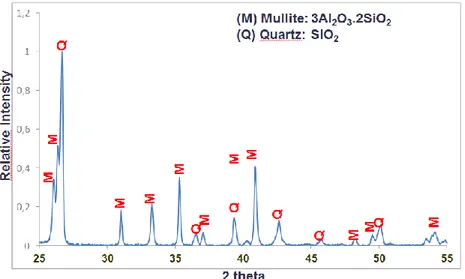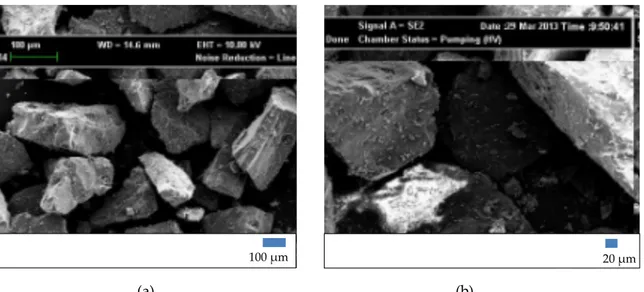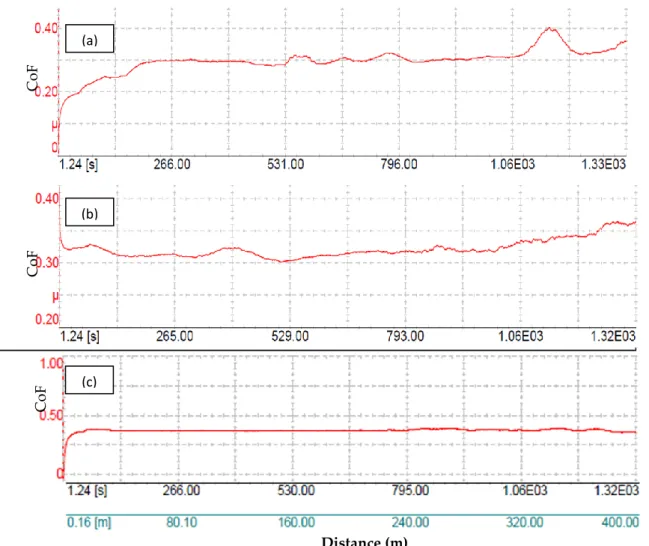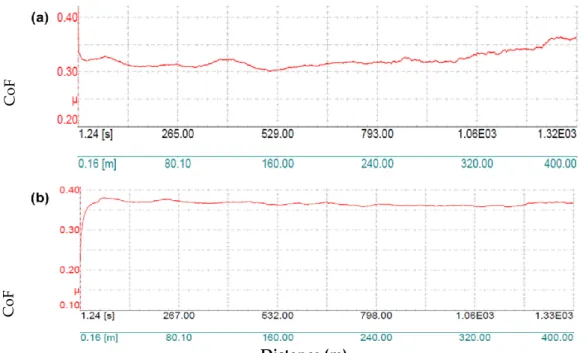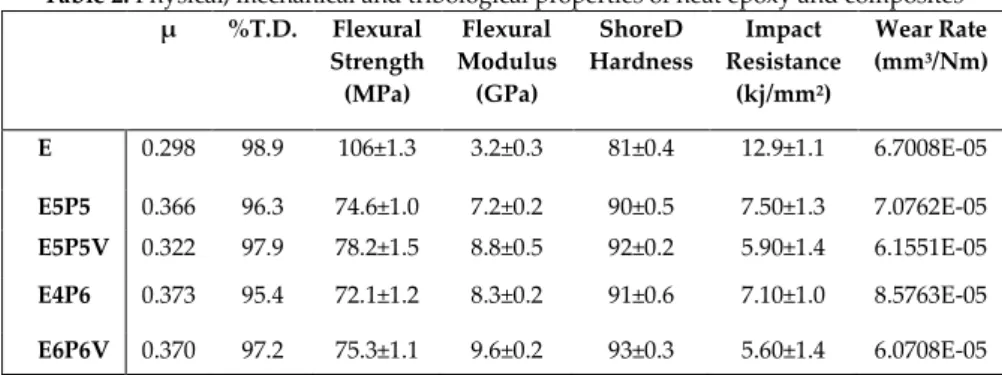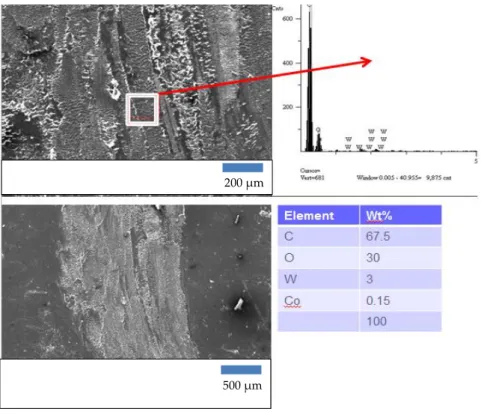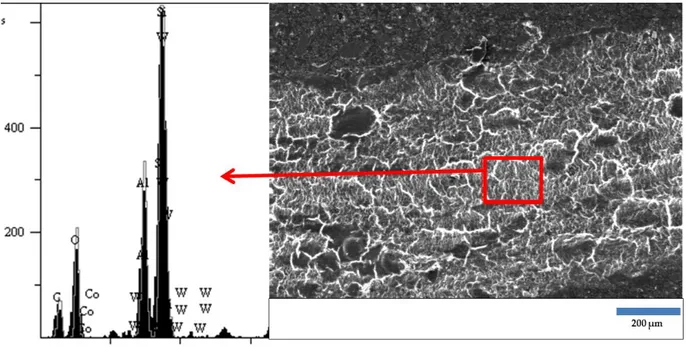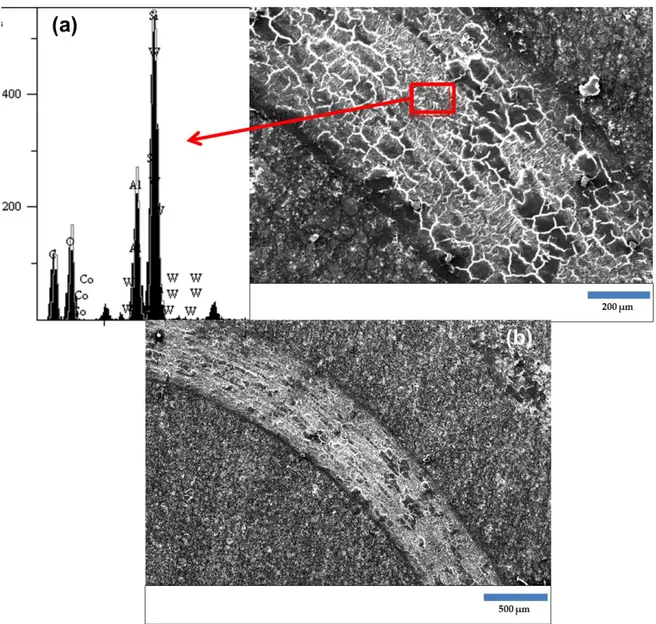INFLUENCE OF VACUUM APPLICATION ON THE TRIBOLOGICAL PROPERTIES OF PORCELAIN WASTE REINFORCED EPOXY COMPOSITES
1*Nurcan Calis ACIKBAS, 2Bilge YAMAN, 3Gokhan ACIKBAS
1Bilecik Seyh Edebali University, Engineering Faculty, Dept. of Metallurgical and Materials Engineering, Gulumbe Campus, TR-11210 Bilecik, TURKEY
2Eskisehir Osmangazi University, Engineering Faculty, Dept. of Metallurgical and Materials Engineering, Meselik Campus, TR-26480, Eskisehir, TURKEY
3Bilecik Seyh Edebali University, Vocational School, Metallurgy Program, Gulumbe Campus, TR-11210 Bilecik, TURKEY
1nurcan.acikbas@bilecik.edu.tr, 2byaman@ogu.edu.tr, 3gokhan.acikbas@bilecik.edu.tr
(Geliş/Received: 29.06.2017; Kabul/Accepted in Revised Form: 28.07.2017)
ABSTRACT: This study evaluates the effect of employment of vacuum application on the mechanical and tribological properties of porcelain waste added epoxy matrix composites. Tribological characterization was determined by friction, wear rate and mechanisms using ball-on-disk test by tungsten carbide counter-part without lubrication at room temperature. It is investigated the role of vacuum application on the wear mechanisms, tribo-chemical layer formation on the wear surfaces, frictional property and tribological performance. The microstructure, mechanical and physical properties and wear behavior correlation were discussed comprehensively. Vacuum application provided fully embedded and well wetted particles, and strong bonding strength between matrix and filler. It is demonstrated that well bonded particle reinforced composites have higher wear resistance, by resulting lower friction coefficient, and more smoother tribochemical layer than compared with the unvacuumed composites.
Key Words: Epoxy matrix composite, Friction, Porcelain waste, Wear, Wear mechanisms
Porselen Atık Takviyeli Epoksi Kompozitlerinin Tribolojik Özelliklerine Vakum Uygulamasının Etkisi
ÖZ: Bu çalışma, vakum uygulamasının atık porselen katkılı epoksi matrisli kompozit malzemelerin mekanik ve tribolojik özelliklerine etkisini değerlendirmektedir. Tribolojik karakterizasyon; tungsten karbür aşındırıcı bilye kullanılarak oda sıcaklığında yağlayıcı olmadan bilye-disk (ball-on-disk) konfigürasyonunda triboloji testleri gerçekleştirilerek sürtünme, aşınma oranları ve aşınma davranışları belirlenmiştir. Vakum uygulamasının; aşınma mekanizmaları, aşınma yüzeylerinde tribo-kimyasal tabaka oluşumu, sürtünme özellikleri ve tribolojik performans üzerindeki rolü araştırılmıştır. Mikroyapı, mekanik ve fiziksel özellikler ile aşınma davranışı ilişkisi ayrıntılı incelenmiştir. Vakum uygulaması partiküllerin daha iyi ıslatılmasına, matris ve partikül arasında daha kuvvetli bağ mukavemeti oluşmasına sebebiyet vermiştir. Vakum uygulamasıyla üretilmiş kompozitler, vakumsuz üretilmiş kompozitlere göre daha düşük sürtünme katsayısı ve daha düzgün tribokimyasal tabakanın oluşmasına sebebiyet vererek daha iyi aşınma dayanımı sergilemişlerdir.
INTRODUCTION
Neat epoxies have excellent chemical resistance and adhesion, light weight, low shrinkage, low friction coefficient and self-lubrication capacity which properties demand in tribological applications (Kumar et al., 2015; Gill and Sidhu, 2016). On the other hand, they have generally low strength and stiffness and high wear loss in comparison with ceramics and metal counterparts. The most important limitation of their usage in demanding tribological applications is their tendency to degrade under different contact conditions, especially corresponding to sliding abrasion and impact erosion (Bobby and Samad, 2016). Various researchers have been studied improvement of tribological properties of the neat epoxies by adding one or more fillers (Srinivasa and Bhagyashekar, 2014; Baptista et. al, 2016; Qi et. al, 2016; Alajmi and Shalwan, 2015; Raju et. al, 2013; Basavarajappa et. al, 2009). Therefore in order to balance between good mechanical properties, low friction and low wear loses there is a need for using polymer matrix composites. For decade’s different kinds of waste materials such as metallurgical slag, waste glass, waste rubber, ceramic wastes, gypsium-fiber like that has been successfully used as filler in polymer matrix composites (Acikbas et. al, 2017; Calis Acikbas and Acikbas, 2017; Acikbas et. al, 2014a; Acikbas et. al, 2014b; Katz and Mileski, 1987; Koleva et al.,, 2011; Alok and Amar, 2008; Pervaiz et. al, 2010; Acikbas and Göçmez, 2015; Acikbas and Göçmez, 2016a; Acikbas and Göçmez, 2016b; Acikbas and Göçmez, 2016c; Katz and Mileski, 1987). The usage of waste material both lessen production cost and eliminate environmental pollution and turn waste materials to value added product.
Tribology basically branch of science and technology investigating friction, wear and lubrication issues. These phenomena result in energy losses and machine break downs, and are of significant economic importance (Bhushan, 2000). It is estimated that approximately one third of the world’s energy resources in present use are consumed in overcoming different kinds of friction and wear. Tribology is extrinsic material property which depends on many systems parameters. But some material properties such as microstructure, toughness, hardness, strength, thermal conductivity, chemical resistance, etc., effect the tribological behavior of materials (Myshkin et. al, 2005; Shi et al., 2004; Suresha et. al, 2006; Vasconcelos et. al, 2006; Yaman and Mandal, 2014; Mallik et. al, 2011; Kumar et. al, 2009; Kumar Mallik et. al, 2012).
Epoxy matrix composites have advantageous over metal counter parts in respect of lower density, less need for maintenance and also lower cost. Even though, higher mechanical strength can be obtained by addition of fillers in epoxy composite, there is also importance of cost reduction in manufacturing of these composites in terms of expensive ceramic and metal fillers. It is well-known that the recycling of industrial waste materials is in great interest for sustainable manufacture regarding economical and effective usage with the ecological environment. Recycling or reuse of waste materials provides preserving the natural resources, saving energy and reduction in material and production costs, etc. From this perspective, waste management strategies, selection of suitable waste filler amongst large amounts of alternative materials, and determination of the proper ratio of suitable filler addition become important issues in the fabrication of waste reinforced composites, recently (Cubeta, 2013).
The size of the world ceramic tableware and ornaments sector is approximately 15 billion $ (Seramik Çalışma Raporu, 2015). During porcelain production the defective products sour to the range of 3 to 10 %. This waste quantity is quite high and it should be reevaluated. Usage of these kinds of waste materials in composite production provides enhanced tribological properties and allows recycling of wastes. The major advantageous of porcelain waste as a reinforcement phase are hardness and strength. Even though porcelain reinforced epoxy composites compared to metals and ceramics have many advantages such as cost-efficiency, easy preparation, self lubrication and so on, there is still insufficient knowledge on the tribology of porcelain added epoxy matrix composite materials.
In addition, porcelain added epoxy based materials becomes a promising alternative material for metallic and ceramics used in biomedicine. The bionic research related to tribology of polymer based composites used in biomedicine has been started and it will need a long time to realize considerable progress (E, 2015). The epoxy requirement for the biomedical applications varies markedly according to
the application being considered (Garcia et al., 2009). Epoxy composite materials can be applied in direct or indirect clinical restorations and used to fabricate dental core and post systems and dental brackets (Tai et al., 2015). It is well-known that wear and hardness are important factors in materials used in dentistry and the wear mechanism is affected by different filler loads and resin matrix (Sagsoz et al., 2014). Hence, it is important to develop good biocompatibility, low cost, low friction and wear, and low creep deformation epoxy based composites to adapt the increasing demand of biomedicine.
The objective of this study, production of high performance composites with addition of porcelain wastes as filler as well as reduces its cost; diminish environmental pollution and enhancing mechanical and tribological properties. Therefore in order to provide a good balance among mechanical properties and cost, 50 and 60 wt%. filler content were studied. And also process ability of resin-filler mixture as taken in consideration for selecting these filler ratios. The microstructure, mechanical, physical properties and tribological behavior relationship was discussed of developed epoxy matrix composites. MATERIAL AND METHOD
Polymer epoxy resin (EpoxAcast690) and hardener was provided from Smoth-on Limited, Canada. EpoxAcast® 690 is a UV resistant clear casting epoxy which can be used applications requiring a rigid, clear finished product. Castings cure with negligible shrinkage and are very hard and strong. Epoxy resin and hardener ratio was 73:27 by weight. Porcelain wastes are an industrial ceramic waste, taken from Porland Porcelain Company, Bilecik, Turkey. Porcelain wastes were ground and then was dry sieved to attain in a particle size between 90 to 150 μm. The porcelain waste preparation procedure and characterization is similar with our previous study (Calis Acikbas and G. Acikbas, 2017). The theoretical density of waste was found as a 2,45 g/cm3 (Micromeritics Accupyc II 1340 model He-gas pycnometer). The phase characterization was carried out by X-ray diffraction analyses (XRD-Panalytical, Empyrean with Cu-Kα radiation). XRD pattern of porcelain waste material was given in Figure 1. The graph revealed that quartz and the mullite are main phases of porcelain waste..
Figure 1. XRD spectra of porcelain wastes (M: mullite; Q: Quartz phases)
Figure 2 represents the secondary electron scanning electron microscopy (Zeiss Supra 40 VP FEG-SEM) images of ground porcelain waste particles. It was shown that waste particles are of irregular shape and sharp edge. Particle size is changing between 75 to 150 microns. The particle shape and size influences physico-mechanical properties and the process ability of composite.
(a) (b)
Figure 2. Representative FEG-SEM images of porcelain waste particles (a) 200x, (b) 500x magnifications The objectives of this study, production of composites with good mechanical properties by adding filler and reduces its cost. Therefore in maintaining a good balance among mechanical properties and cost, 50 and 60 wt% filler content were studied as taken reference in our former study (Table 1) (Acikbas et. al. 2014). And also process ability of resin-filler mixture as taken in consideration. Because addition of more than 60 wt.% filler would not be workable mix when it is prepared. On the other hand waste particle size kept as constant as between 90 to 150 microns. In order to observe the effect of vacuum, composites were produced with and without vacuum application. Vacuum was applied for 5 minutes, in order to remove bubbles in mixture. The coding is as follows: the first two figures represent the epoxy content. E5 means 50wt.% epoxy content. The two figures following 4 and 5, represent the waste content and the last figure represent the process condition. V means composites were produced under vacuum.
Table 1. Specifications of prepared composite materials
E E5P5 E5P5V E4P6 E4P6V
Epoxy (wt%) 100 50 50 40 40 Porcelain Waste (wt%) 0 50 50 60 60 Process Condition Without Vacuum Without Vacuum With Vacuum Without Vacuum With Vacuum
Polymer matrix composites were produced with the casting method. Detailed description of composites production stages were given in our previous study (Calis Acikbas and G. Acikbas, 2017). After production of composite materials some mechanical tests, analysis and characterization techniques were applied in order to determine properties. The theoretical densities of the waste and epoxy resin were used to calculate the theoretical density of the composites by using law of mixture as following equation (Harris, 1999).
ρc = ρm . Vm + ρr . Vr (1)
where ρc, theoretical density of composite, ρm, theoretical density of matrix, ρr, theoretical density of reinforcement, Vm, volume fraction of matrix, Vr, volume fraction of reinforcement.
In order to measure the density and porosity of the samples the Archimedes principle was used. Bulk density, %theoretical density, and %total porosity were determined using the following equations. Bulk Density = water x W W W 2 3 1 (2) %T.D. = 100 . . x D T D B (3) % Total Porosity = 100 - %T.D. (4) where W1 is dry weight, W2 is wet weight suspended in water, W3 is wet weight, B.D. is Bulk
Density, T.D. is Theoretical Density of samples.
Hardness values of composites were determined by Shore-D hardness measurement method. 3 point- flexural strength tests of samples was carried out according to TS 985 EN ISO 178 standard.At least five samples were used for mechanical tests. The flexural strength, elongation, flexural modulus were determined after 3 point- flexural strength test. The flexural modulus of composites was calculated using the following equation.
xm
WD
L
E
3 34
(5)where E is the flexural modulus, L is the distance between the span, m is slope, D is thickness and W is the width of the tested samples.
Wear characterization of the samples was determined with regards to friction, wear rates and mechanisms by carrying out ball-on-disk test. Tribometer designed according to DIN 50 324 and ASTM G 99-95a in a ball-on-disk configuration. Tungsten carbide ball is used as counter-part. 3N load was applied and tests were maintained to 400m. Wear track radius was selected as 5mm with the linear speed of 30cm/s. Surface profilometer (Mitutoyo SJ-401) was used in an attempt to calculate wear areas. Calculated surface areas integrated all over the circle of tracks and then the volumes were computed. Wear volume (V) divided by load (N) and wear distance (L) and the wear rates (W) were computed, as given in Eq. 6;
(6)
The microstructural analysis of the worn surfaces of neat epoxy and composites was carried out scanning electron microscope (SEM-Zeiss Supra 40VP) after tribological tests.
RESULT AND DISCUSSION
As it is seen from the graphics, coefficient of friction (CoF) of developed epoxy and epoxy matrix composites are changing between in 0.3 to 0.37 (Fig.3). Even the coefficient of friction is increased with the addition of hard ceramic fillers as expected, it can be considered that the friction behavior of epoxy is not affected majorly, according to these obtained close coefficient of friction values. The effect of production process on the friction behavior can be seen obviously in Fig 4, in comparison of porcelain added composite in same reinforcement content. It is achieved very close value of coefficient of friction in 50wt.% porcelain added composites (0.32) fabricated under vacuum compared to neat epoxy
coefficient of friction (0.30), whilst coefficient of friction of same composition fabricated without vacuum was obtained as high value as 0.36.
Distance (m)
Figure 3. The friction coefficient graphs of (a) neat epoxy, (b) E5P5 and (c) E4P6 composites (a) (b) Co F Co F Co F (c)
Distance (m)
Figure 4. The effect of vacuum application on coefficient of friction (a) E5P5, (b) E5P5V composites Table 2 shows some mechanical and physical properties of composites and its correlation with tribological behavior. The neat epoxy sample has the highest %T.D. value. The addition of fillers into epoxy provides more porous structure due to the formation of hard mixable mixture with increased viscosity. Vacuum application has positive effect on porosity elimination and hence higher %T.D. values were obtained. The flexural strength of neat epoxy is the highest one due to plastic behavior. With the addition of hard ceramic fillers into epoxy resin results in decreasing flexural strength values due to more brittleness structure. Since the vacuum application provides better interface bonding, flexural strength values showed a slight increase. Neat epoxy has the lowest flexural modulus and hardness as expected. The addition of hard particles enhances the flexural modulus as well as hardness. The addition of ceramic particles decreases the impact resistance. Vacuum applied and 60wt.% ceramic containing epoxy samples has the lowest wear rate and show high wear resistance. Hard ceramic particles has positive effect on wear rate since they carry load and provides in strengthening the surface which will result in improving the wear resistance of the polymer. As a result from the table, addition of filler and vacuum application enhances some mechanical properties. According to the literature, in order to develop or enhance the tribological properties of neat epoxies; the most common used reinforcements can be summarized as graphite; which helps in formation of lubricant film (Pan et.al., 2010), carbon nano tubes (CNT); that leads to improved tensile and flexural strength (Zhou et.al, 2008), graphene; which has high mechanical strength and fracture toughness (Khun et.al., 2015), titanium dioxide (TiO2); which helps to improve wear and impact resistance (Zhang et al., 2004), boron nitride (BN); which shows good mechanical properties (Gu et al., 2011), alumina (Al2O3); which improves the compressive strength, mechanical properties and also the wear resistance (Mohanty and Srivastava, 2012), nano clay (montmorillonit); that imparts a high wear resistance (Esteves et.al., 2013), polytetrafluoroethylene (PTFE) which acts as a lubricant (McCook et.al., 2006), etc. Zhang et al. (2004) studied wear properties of 15 vol% graphite, 5 vol% nano-TiO2 and 15 vol% carbon fiber added epoxy composites against carbon steel ring (100Cr6) using a block-on-ring apparatus under dry conditions at the rotational speed of 1 m/s, under 1 MPa load. They reported a specific wear rate of composites of 3,2 × 10-7 mm3/Nm, which is about 100 times lower when compared to neat epoxy. Luo et al.(2010), used a chemical grafting method to modify nano-Si3N4, in order to improve the dispersion of nano-particles in the epoxy matrix and investigated the tribological behavior by pin-on-ring test configuration under the pressure of 3MPa. In comparison to the composites filled with untreated nano-Si3N4 particles, the composites with the grafted
Co
F
Co
nano-Si3N4 exhibit improved sliding wear resistance and reduced friction coefficient owing to the good chemical bonding at the filler/matrix interface. Khun et al.(2015), used graphene as a filler and tribology tests were carried out using a 100 Cr 6 steel ball on disk tribometer under a constant load of 1N over a sliding distance of 300 m. Increasing the graphene content resulted in reduced coefficient of friction and wear rate which explained by the formation of a tribochemical film owing to the presence of graphene sheets act as a solid lubricant in the interface. Consequently, it can be concluded that there are extensive studies in the literature related of tribological behavior of epoxy composites, on the other hand, the tribological behavior of porcelain added epoxy composites have not yet been explored comprehensively. In addition, it is well known that the variation of friction and wear rate depends on interfacial conditions such as normal load, geometry, relative surface motion, sliding speed, surface roughness of the rubbing surfaces, and type of material, system rigidity, temperature, stick slip, relative humidity, lubrication and vibration. Moreover; amongst them sliding speed and normal load are the two dominant factors in the variation of friction and wear rate (Chowdhury et al., 2011). Hence, in order to support these present experimental results, the findings were compared with the wear properties of neat epoxy in the literature. Vasconcelos et al. (2006), investigated the wear properties of epoxy resin based composites containing aluminum and milled carbon or glass fibers against steel (105Cr6) in dry conditions by reciprocating test at room temperature using 25N load and linear velocity of 0.13 m/s. Initially, at room temperature the neat epoxy exhibit a constant friction coefficient of 0.16 and after about 30m of sliding distance, μ began to increase to 0.40 probably due to the thermal softening of the resin, as a result of the pressure and heat generated on the interface contact. Specific wear rate of neat epoxy obtained as 1.82x10−5 mm3/Nm. Sirinas and Bhagyashekar (2014), studied tribological behaviour of epoxy composites containing three different particulate fillers; Gr, SiC and Gr-SiC. Tribological tests conducted on a Pin on Disc type wear tester under dry sliding conditions under applied loads of 10-30N with the sliding velocity of 5.23m/s and obtained 0.76 of friction coefficient and wear rate of 9.92x10−5 mm3/Nm. The present study’s test results are in good agreement with results in the literature. Although friction behavior is related to normal load, the differences in friction coefficient can be explained by there is no proportionality between these friction and load parameters and polymers behaves differently according to the various types of surface interactions and various test methods.
Table 2. Physical, mechanical and tribological properties of neat epoxy and composites μ %T.D. Flexural Strength (MPa) Flexural Modulus (GPa) ShoreD Hardness Impact Resistance (kj/mm2) Wear Rate (mm3/Nm) E 0.298 98.9 106±1.3 3.2±0.3 81±0.4 12.9±1.1 6.7008E-05 E5P5 0.366 96.3 74.6±1.0 7.2±0.2 90±0.5 7.50±1.3 7.0762E-05 E5P5V 0.322 97.9 78.2±1.5 8.8±0.5 92±0.2 5.90±1.4 6.1551E-05 E4P6 0.373 95.4 72.1±1.2 8.3±0.2 91±0.6 7.10±1.0 8.5763E-05 E6P6V 0.370 97.2 75.3±1.1 9.6±0.2 93±0.3 5.60±1.4 6.0708E-05
Besides the determination of coefficient of friction and calculation of wear rates, microstructural characterization were carried out in order to explain wear mechanisms occurred at the interface. SEM-SE and EDX images of neat epoxy sample’s worn surfaces were given in Fig.5. In the case of neat epoxy, wear debris and abrasive wear tracks and tribolayer formation are seen. Generally, it is known that tribological properties of polymer-based composites are improved according to the formation of transfer film and the enhancement of mechanical and thermal properties. Wear scars on the worn surface indicate the abrasion of the epoxy matrix by the asperities of the counter face. According to EDX analysis, C and O are main elements of tribolayer. The presence of little amount of W and Co elements, sign that abrasion wear since these elements come from ball.
Figure 5. SEM-SE and SEM-EDX analysis of worn neat epoxy surfaces
From the EDX analysis of E5P5/E5P5V samples (Fig. 6 and 8), addition of filler provides thicker tribofilm formation compared to neat epoxy. The formation of thicker tribofilm than the neat epoxy can be explained by the difficulty of formation tribofilm since ceramic phases provides high degree of brittleness, high wear rate and coefficient of friction. The matrix-filler interface bonding is weak of E5P5 sample (see Fig.7). Increased interfacial strength between the matrix and fillers with application of vacuum results in less wear and changes were observed in tribolayer characteristics (Fig. 8 and 9). The enhancement of interface bonding strength between epoxy and porcelain particles lead to changes in tribolayer feature that shifts from fragile to more continuous. This affects the friction coefficient and wear rate. Due to weak interface bonding, more grain pullout was observed and hence rougher worn surface was obtained with E5P5 sample compared to E5P5V sample. Also EDX analysis results confirm this phenomenon (Fig. 6 and 8). With vacuum application Si, Al and O peaks intensity is getting lower values, which indicates less abrasive wear in load-carrier porcelain particles.
200 μm
Figure 6. SEM-EDX analysis of worn E5P5 sample surface
(a) (b)
Figure 8. SEM-EDX analysis of worn E5P5V sample surface
(a) (b)
Figure 9. (a) Wear scar of E5P5V sample, (b) FEG-SEM image of matrix-filler interface of E5P5V sample (better interface connectivity between matrix and filler with vacuum application)
From the EDX analysis of E4P6V samples worn surfaces, Si, Al, O and C peaks are obtained as main elements (Figure 10). This shows that tribofilm containing of porcelain particles and polymer. Because of the high elastic modulus and abrasion resistance of the porcelain particles, they carry most loads during the friction process and so decrease significantly the wear of the matrix. The addition of the fillers assists in strengthening the surface which will result in improving the wear resistance of the epoxy. With vacuum application, good interface bonding strength decrease the particle pull-out amount and cause less wear losses. The uniformity and thickness of this layer is increased with increasing filler content. The addition of more rigid particles into epoxy resin enhances the mechanical properties such as hardness and flexural modulus. This can lead to higher abrasion resistance of composites than the epoxy matrix.
Figure 10. (a) SEM-EDX analysis of worn E4P6V surface and (b) FEG-SEM image of wear scar of E4P6V CONCLUSION
Based on experimental studies, the following results can be drawn. With the addition of filler; CoF, %T.D., flexural modulus, hardness increased, flexural strength, impact resistance and wear rate decreased. With increasing filler content; CoF, flexural modulus, hardness, wear rate enhanced, %T.D., flexural strength, and impact resistance reduced. Vacuum application leads to improvement in %T.D., flexural strength, flexural modulus, hardness and decrease in CoF, impact resistance and wear rate. Vacuum application provides fully embedded and well wetted particles, and strong bonding strength between matrix and filler and hence better tribological behavior was obtained. Wear mechanisms can be summarized as tribolayer formation, adhesive wear and abrasive wear.
REFERENCES
Acikbas, G., Ozcan, S., Calis Acikbas, N., 2017, “Production and Characterization of a Hybrid Polymer Matrix Composite”, Polymer Composites, DOI: 10.1002/pc.24471
Acikbas, G., Calis Acikbas, N., Ikizek, E., Ozel, M., Eker, A. S., 2014a, “Characterization of Green Epoxy Matrix Composites Filled with Ceramic Wastes”, Caglar, N., ISITES2014 2nd International Symposium on Innovative Technologies in Engineering and Science, Karabük, Turkey,
597-606, 18-20 June, 2014, pp. Academic Platform, available at:
http://www.isites.info/pastconferences/isites2014/isites2014/papers/A16-ISITES2014ID96.pdf Acikbas, G., Calis Acikbas, N., Keskin, A., Ari, O. K., Ucer, D., 2014b, “ Effect of Graphite Filler Loading
Concentration on Physical and Mechanical Properties of Epoxy Matrix Composites”, SERES’14 ‘III. International Ceramic, Glass, Porcelain Enamel, Glaze and Pigment Congress, Eskisehir, Turkey, 15-17 October 2014.
Acikbas, G. and Göçmez, H., 2015, “Polyester Matrix Composites Containing Marble Waste”, International Porous And Powder Materials Symposium And Exhibition, İzmir, Turkey, 15-18 September 2015, available at: http://www.ppm2015.org/metin.aspx?ID=1420
Acikbas, G., Göçmez, H., 2016, “Effect of Glass Fiber Waste Content on Polyester Matrix Composites”, paper presented at the 1st International Black Sea Congress on Environmental Sciences,
Giresun-Turkey, 31 August- 3 September, 2016, available at:
http://muhendislik.giresun.edu.tr/fileadmin/user_upload/BOLUMLER/Cevre/IBCESS_Abstract _Book.pdf.
Acikbas, G., Göçmez, H., 2016, “Effect of Vitreous China Sanitaryware Waste Amount on Polyester Matrix Composite Properties”, 3.International Symposium on Environment and Morality,
Alanya-Turkey, 4-6 November 2016, available at:
http://isem.info/PastConferences/ISEM2016/ISEM2016/papers/1-ISEM2016ID342.pdf.
Alajmi, M., Shalwan, A., 2015, “Correlation between Mechanical Properties with Specific Wear Rate and the Coefficient of Friction of Graphite/Epoxy Composites”, Materials, Vol. 8, pp. 4162-4175; doi:10.3390/ma8074162.
Alok, S., Amar, P., 2008, “Analysis of Dry Sliding Wear Behaviour of Red Mud Filled Polyethylene Composites Using Taguchi Method”, Journal of Reinforced Plastics and Composites, Vol. 29, (24).
Baptista, R., Mendão, A., Rodrigues, F., Figueiredo-Pina, C.G., Guedes, M., Marat-Mendes R., 2016, “Effect of High Graphite Filler Contents on the Mechanical And Tribological Failure Behavior of Epoxy Matrix Composites”, Theoretical and Applied Fracture Mechanics, Vol. 85, pp. 113– 124.
Basavarajappa, S., Arun, K.V., Paulo Davim, J., 2009, “Effect of Filler Materials on Dry Sliding Wear Behavior of Polymer Matrix Composites – A Taguchi Approach”, Journal of Minerals & Materials Characterization & Engineering, Vol. 8, No.5, pp 379-391.
Bhushan, B., 2000, Modern Tribology Handbook, Two Volume Set, CRC Press, ISBN 9780849384035, December 28, Pages 1760 .
Bobby S., Abdul Samad, M., 2016, “Enhancement of Tribological Performance of Epoxy Bulk Composites and Composite Coatings Using Micro/Nano Fillers: A Review”, Polymers for Advanced Technologies, October 2016, DOI: 10.1002/pat.3961.
Calis Acikbas N., Acikbas, G., 2017, “Epoxy Matrix Composites Containing Urea Formaldehyde Waste Particulate Filler”, Waste and Biomass Valorization, Vol.8, pp. 669–678.
Chowdhury, M. A., Khalil, M. K., Nuruzzaman, D. M., Rahaman, M. L. 2011, “The Effect of Sliding Speed and Normal Load on Friction and Wear Property of Aluminum”, Int. J. Mech. Mechatron. Eng, Vol. 11 (01), pp. 53-57.
Cubeta, Richard A., 2013, “Utilizing Recycled Fiberglass for Affordable”, Green Composite Technology, COMPOSITES 2013, American Composite Manufacturers Association, January 29-31, 2013 Orlando, FL-USA.pp. 1-5.
E, S.F., Shi, L., Guo, Z.G., Liu, W.M., 2015, “The Recent Progress of Tribological Biomaterials”, Biosurface and Biotribology, Vol. 1,pp.81–97.
Esteves, M., Ramalho, A., Ferreira, M. A. J., Nobre, P. J. 2013, “Tribological and Mechanical Behaviour of Epoxy/Nanoclay Composites”, Tribology Letters, Vol. 52 (1), pp.1 –10.
Garcia, F.G., Leyva, M. E., Alencar de Queiroz, A. A., Higa, O. Z., 2009, “Epoxy Networks for Medicine Applications: Mechanical Properties and In Vitro biological Properties”, Journal of Applied Polymer Science, Vol. 112, pp.1215–1225.
Gill C.S and Sidhu, J.S., 2016, “Dry Sliding Wear Behavior of Epoxy Based Composites Filled With WS2 and B4C”, International Journal of Material Sciences and Technology, Vol 6, No. 1, pp. 21-32. Gu, J., Zhang, Q., Dang, J., Xie, C., 2012, “Thermal Conductivity Epoxy Resin Composites Filled with
Boron Nitride”, Polymers for Advanced Technologies, Vol. 23(6), pp. 1025–1028. Harris, B., 1999, Engineering Composite Materials, The Institute of Materials, London
Katz H.S., Mileski, J.V., 1987, Handbook of Fillers For Plastics, Springer Science&Business Media, Technology & Engineering .
Khun, N. W., Zhang, H., Lim, L. H., Yang, J., 2015, “Mechanical and Tribological Properties of Graphene Modified Epoxy Composites”, International Journal of Applied Science and Technolog, Vol. 8(2), pp. 101–109.
Koleva, M., Zheglova, Fidancevska, A., Vassilev,, E. V., 2011, “Composites Containing Waste Materials”, INTECH Open Access Publisher.
Kumar, V., Sinha S. K. and Agarwal, A. K. , 2015, “Tribological Studies of Epoxy and Its Composite Coatings on Steel in Dry and Lubricated Sliding”, Tribology, Vol 9, No 3, pp.144-153.
Kumar, R., Calis Acikbas, N., Kara, F., Mandal, H., Basu, B., 2009, “Microstructure - Mechanical Properties - Wear Resistance Relationship of SiAlON Ceramics”, Metallurgical and Materials Transactions A, pp.2319-2332.
Kumar Mallik, A., Calis Acikbas N., Kara, F., Mandal, H., Basu, D., 2012, “A Comparative Study of SiAlON Ceramics”, Ceramics International, pp.5757–5767.
Kumar Mallik, A., Reddy, M., Calis Acikbas, N., Kara, F., Mandal, H., Basu, D., Basu, B., 2011, “Influence of SiC addition on tribological properties of SiAlON”, Ceramics International, pp.2495–2504. Luo, Y., Yu, X. Y., Dong, X. M., Rong, M. Z., Zhang, M. Q. 2010, “Effect of nano-Si3N4 Surface
Treatment on the Tribological Performance of Epoxy Composite”, Express Polymer Letters, Vol.4, No.3, pp. 131-140
McCook, N. L., Boesl, B., Burris, D. L., Sawyer, W. G. 2006, “Epoxy, ZnO, and PTFE Nanocomposite: Friction and Wear Optimization”, Tribology Letters, Vol. 22 (3), pp. 253–257.
Mohanty, A., Srivastava, K. V., 2012, “Effect of Alumina Nanoparticles on the Enhancement of Impact and Flexural Properties of the Short Glass/Carbon Fiber Reinforced Epoxy Based Composites”, Int. J. Sci. Eng. Res. Vol. 3(11), pp. 1–7.
Myshkin, N.K., Petrokovets, M.I., Kovalev, A.V. , 2005, “Tribology of Polymers: Adhesion, Friction, Wear, and Mass-Transfer”, Tribology International, Vol. 38, pp. 910–921.
Qi, H., Zhang, G., Wetzel, B., Österle, W., Wang, T., Wang, Q., 2016, “Exploring the Influence of Counterpart Materials on Tribological Behaviors of Epoxy Composites”, Tribology International, Vol.,103, pp. 566–573.
Pan, G., Guo, Q., Ding, J., Zhang, W., Wang, X., 2010, “Tribological Behaviors of Graphite/Epoxy Two-Phase Composite Coatings”, Tribology International, Vol.43, pp.1318–1325.
Pervaiz, M.R., Mohanthy, S., Nayak, S.K., Mahanwar, P.A. , 2010 , “Composites Reinforced with Fly Ash and Mica”, Journal of Minerals & Materials Characterization & Engineering, Vol. 9, pp. 25-41. Raju, B. R., Suresha, B., Swamy, R. P., Kanthraju, B. S. G. , 2013, “Investigations on Mechanical and
Tribological Behaviour of Particulate Filled Glass Fabric Reinforced Epoxy Composites”, Journal of Minerals and Materials Characterization and Engineering, Vol.1, pp.160-167.
Sagsoz, O., Ilday, N. O., Sagsoz, N. P., Bayindir, Y. Z., Alsaran, A., 2014, “Investigation of Hardness and Wear Behavior of Dental Composite Resins”, International Journal of Composite Materials, Vol.4(4), pp. 179-184.
Srinivas, K., Bhagyashekar, M.S., 2014, “Wear Behaviour of Epoxy Hybrid Particulate Composites”, Procedia Engineering, Vol. 97, pp. 488 – 494.
Shi G., Zhang M.Q., Rong M.Z., Wetzel B., Friedrich K., 2004, “Sliding Wear Behavior of Epoxy Containing nano-Al2O3 Particles with Different Pretreatments”, Wear, Vol. 256, pp. 1072–1081. Suresha B., Chandramohan G., Prakash J.N., Balusamy V., Sankaranarayanasamy K., 2006, “The Role of Fillers on Friction and Slide Wear Characteristics in Glass-Epoxy Composite Systems”, Journal of Minerals and Materials Characterization and Engineering, Vol. 5, pp. 87-101.
Tai, Y.-Y., Hsu, S.-H., Chen, R.-S., Su, W.-F., Chen, M.-H. , 2015, “Liquid Crystalline Epoxy Nanocomposite Material for Dental Application”, Journal of the Formosan Medical Association, Vol.114, pp.46-51.
Vasconcelos P.V., Lino F.J., Baptista A.M., Neto R.J.L., 2006, “Tribological Behavior of Epoxy Based Composites for Rapid Tooling”, Wear, Vol. 260, pp. 30–39.
Yaman, B., Mandal, H. , 2014, “ Wear Performance of Spark Plasma Sintered Co/WC and cBN/Co/WC Composites”, International Journal of Refractory Metals and Hard Materials, Vol.42, pp. 9–16.
Seramik Kalkınma Raporu, available at:
http://www.kalkinma.gov.tr/Lists/zel%20htisas%20Komisyonu%20Raporlar/Attachments/266/ Seramik%20%C3%87al%C4%B1%C5%9Fma%20Grubu%20Raporu.pdf
Zhang, Z., Breidt, C., Chang, L., Haupert, F., Friedrich, K., 2004, “
Enhancement of the Wear Resistance
of Epoxy: Short Carbon Fibre, Graphite, PTFE and nano-TiO2
”, Composites Part A: Applied Science and Manufacturing, Vol. 35, pp. 1385–1392.Zhou, Y. X., Wu, P. X., Cheng, Z. Y., Ingram, J. , Jeelani, S. 2008, “Improvement in Electrical, Thermal and Mechanical Properties of Epoxy by Filling Carbon Nanotube”, Express Polymer Letters, Vol. 2(1), pp. 40–48.
